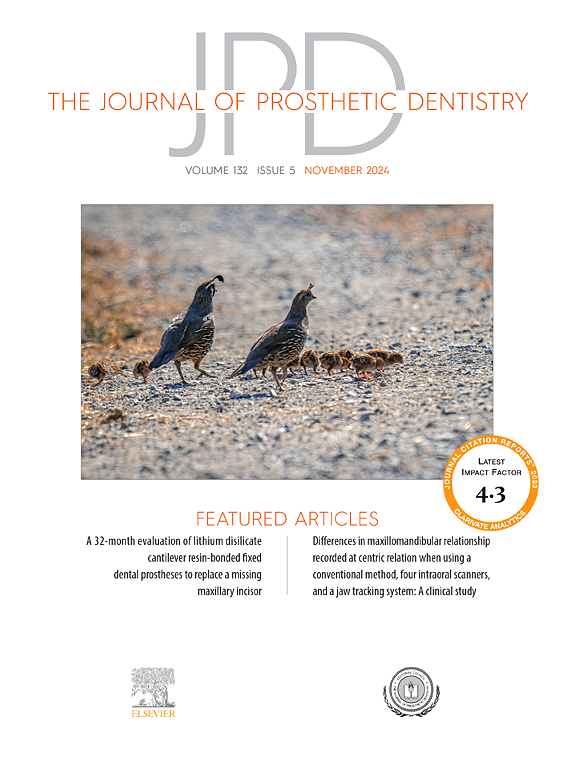假牙使用与死亡率:随时间变化的机器学习暴露分析。
IF 4.8
2区 医学
Q1 DENTISTRY, ORAL SURGERY & MEDICINE
引用次数: 0
摘要
问题陈述:牙齿脱落与死亡风险增加有关,使用义齿可以通过恢复咀嚼功能来减轻这种影响。然而,大多数研究仅在基线时调查了义齿的使用情况,并没有考虑随访期间的变化。目的:本前瞻性队列研究的目的是研究日本老年人假牙使用随时间变化的暴露与死亡率之间的关系。材料和方法:数据来自日本老年学评价研究,研究对象为≥65岁的独立成人。基线问卷调查于2013年进行,参与者截至2022年的全因死亡率数据来自当地市政数据库(n=47 698;中位随访:9.2年)。2016年和2019年的问卷调查收集了时变暴露和协变量信息。使用集成机器学习和控制协变量的双鲁棒估计器来估计生存概率。对所有参与者进行分析,结果:参与者中,19.0%在随访期间死亡,55.8%在基线时使用了义齿。持续使用义齿患者的生存率高于持续不使用患者(平均治疗效果[ATE]=3.7%;95%置信区间[CI]: 0.3, 7.0)。结论:在日本老年人中,持续使用义齿与提高生存率相关。这种关联在天然牙齿较少的参与者中更为明显。本文章由计算机程序翻译,如有差异,请以英文原文为准。
Dental prosthesis use and mortality: A time-varying exposure analysis with machine learning
Statement of problem
Tooth loss has been associated with an increased risk of mortality, and dental prosthesis use may mitigate the effect by recovering masticatory function. However, most studies investigated dental prosthesis use only at baseline and did not consider changes during the follow-up.
Purpose
The purpose of this prospective cohort study was to examine the association between dental prosthesis use as a time-varying exposure and mortality in older Japanese adults.
Material and methods
Data from the Japan Gerontological Evaluation Study were used, targeting independent adults aged ≥65 years. The baseline questionnaire survey was conducted in 2013, and all-cause mortality data of participants up to 2022 were obtained from the local municipality database (n=47 698; median follow-up: 9.2 years). The 2016 and 2019 questionnaire surveys collected time-varying exposure and covariate information. A doubly robust estimator with ensemble machine learning and controlling for covariates was used to estimate survival probability. The analysis was conducted on all participants, those with <20 natural teeth and those with <10 natural teeth.
Results
Of the participants, 19.0% died during follow-up and 55.8% used dental prostheses at baseline. Consistent dental prosthesis use was associated with higher survival probability than consistent nonuse (average treatment effect [ATE]=3.7% points; 95% confidence interval [CI]: 0.3, 7.0). Greater associations were revealed for those with fewer natural teeth (for those with <10 natural teeth, ATE=10.0% points; 95% CI: −0.6, 20.6).
Conclusions
Consistent dental prosthesis use was associated with increased survival probability in older Japanese adults. This association was greater among participants with fewer natural teeth.
求助全文
通过发布文献求助,成功后即可免费获取论文全文。
去求助
来源期刊

Journal of Prosthetic Dentistry
医学-牙科与口腔外科
CiteScore
7.00
自引率
13.00%
发文量
599
审稿时长
69 days
期刊介绍:
The Journal of Prosthetic Dentistry is the leading professional journal devoted exclusively to prosthetic and restorative dentistry. The Journal is the official publication for 24 leading U.S. international prosthodontic organizations. The monthly publication features timely, original peer-reviewed articles on the newest techniques, dental materials, and research findings. The Journal serves prosthodontists and dentists in advanced practice, and features color photos that illustrate many step-by-step procedures. The Journal of Prosthetic Dentistry is included in Index Medicus and CINAHL.
 求助内容:
求助内容: 应助结果提醒方式:
应助结果提醒方式:


